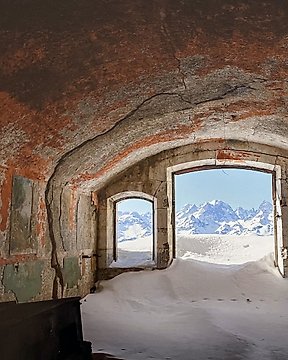
Michel Eisenlohr - Ouvrage des Gondrans 2020
Nº 18203225

Nº 18203225

Oil on panel 70x50 cm, dedication, signature and date on top right, dedication to his wife Dina, the name of his wife can also be found in the work.
Work is preserved in very good condition, beautiful brushstrokes, as shown in photos. The painter in this work didn’t spare any material, for sure.
With certificate of authenticity issued by an art gallery.
Origin: Art gallery, then private collection
Frame made of gilded wood.
Biography:
Emilio Notte (Ceglie Messapica, 30th January 1891 – Naples, 7th July 1982) was an Italian painter, exponent of the Futurism movement.
His father Giovanni (from Marostica) and his mother Lucinda Chiumenti Fincati (from Vicenza) had arrived in Ceglie for work reasons (Giovanni was an official of the Ministry of Stamps). The relocations followed one another for similar reasons: first to Lagonegro, then to Serino, Bovino and Sant'Angelo dei Lombardi (where Notte attended middle and high school in the local Seminary, demonstrating, however, an early artistic talent). In 1906 the family decided to send the young Emilio to Naples, where he was welcomed by Vincenzo Volpe, who succeeded Domenico Morelli in the direction of the Academy of Fine Arts. In 1907 the family moved to Prato, so that Notte could complete his studies at the Academy of Fine Arts in Florence.
His master in Florence is Adolfo De Carolis, but he also attended the old Giovanni Fattori's studio, whose poetics is more congenial to him. Between Florence and Prato interesting friendships began for Notte: with the future architect Giovanni Michelucci, with the painter Attilio Cavallini, with Plinio Nomellini and Galileo Chini, who introduce him in the group of 'Giovine Etruria'. At De Carolis’ studio he also met Gabriele D'Annunzio. Above all, in Prato, Notte binds himself with a deep friendship to the Lacerba poet and essayist Bino Binazzi, who introduces him to Curzio Malaparte, Dino Campana and Ardengo Soffici. The last one was a crucial event. In the Sixties, Notte's painting shifted in more philosophical, even hermetic directions, as in the series of 'quadri neri' from the 'periodo del Vulcano', inspired by the solitary atmospheres of the Aeolian islands, where the artist spent long periods, and later in the series of 'quadri bianchi' from the 'periodo delle pietre' (1965-1974); among these I ragazzi e la pietra, Pianto di Edipo, Il sogno di Giacobbe and Morte dell'eroe.
But these meditations on the inner atmospheres, probably influenced by the contemporary frequentation of personalities of the literary world, from Carlo Levi to Eduardo De Filippo (of whom he will make a portrait), from Michele Prisco to Eugenio Montale (he will illustrate his collection of poems), are interrupted by the enthusiasm for space exploits, to which Notte dedicates innumerable 'frammenti' ('fragments') of futuristic structure, so called because of their irregular shape, which could be defined as the evolution of aeropainting into 'astropainting'. Among these Intorno alla Luna, Terra-Luna, Sbarco sulla Luna.
From the Sixties on, his dramatic vision of life exploded in a series of large-sized canvases, often allegorical works, such as La strage dei pionieri from 1974, or like the large Crocifissione nº 1 from 1971, a synthesis between futurism and expressionism, and the large Crocifissione nº 2 (today in the Pinacoteca Emilio Notte in Ceglie Messapica): complementary works, because while in the first Jesus is depicted living and torn, and the whole composition focuses on the tension of his body and face, in the second one Christ's body is relaxed in the inertia of death, colours are less livid, while the background is made of a gold leaf grid, in the Byzantine and fourteenth-century style, with evident references to the victory of spiritual light over painful darkness of the flesh.
Comment acheter sur Catawiki ?
1. Découvrez des objets d’exception
2. Faites la meilleure offre
3. Effectuez un paiement sécurisé